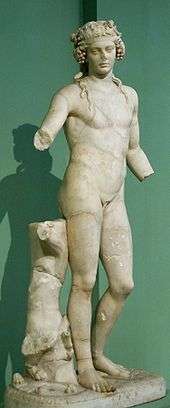Horti Liciniani
The Horti Liciniani[1] were a set of gardens in ancient Rome originally belonging to the gens Licinia. In the third century, these were owned by the Emperor Gallienus,[2] himself a member of the gens. The gardens were probably on the Esquiline Hill, at the top of which Gallienus erected a colossal statue of himself.[3] The 4th-century domed nymphaeum that survives, long miscalled a "Temple of Minerva Medica", is believed to have been part of the gardens.

Dionysus of Pentelic marble discovered in the nymphaeum, 1879 (Capitoline Museums)
Notes
- Maddalena Cima, "Gli Horti Liciniani: una residenza imperiale nella tarda antichità", in Horti Romani, Atti del Convegno Internazionale Roma, 4-6 maggio 1995, Eugenio La Rocca, ed. (Rome), 1998.
- Historia Augusta, "Gallienus", 17.
- in summo Esquiliarum monte ibid, 18. The Palatium Licinianum stood near the site of the church of Santa Balbina; an arcus Gallieni stood at the Esquiline gate (porta Esquilina LacusCurtius.com: Horti, with bibliography
gollark: It should be timestamped, hold on.
gollark: It's more of a brown-green.
gollark: Oooo, roles!
gollark: Wait, I can still be SECRETLY accces leval 0, it's fine.
gollark: NOOOOOOOOOOOOOOO!
This article is issued from Wikipedia. The text is licensed under Creative Commons - Attribution - Sharealike. Additional terms may apply for the media files.